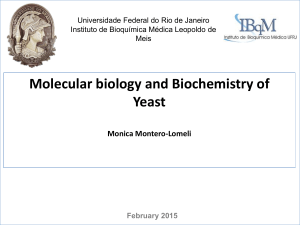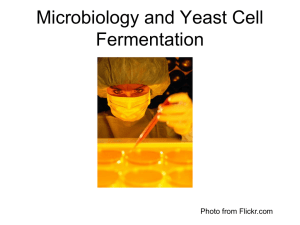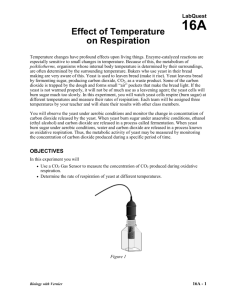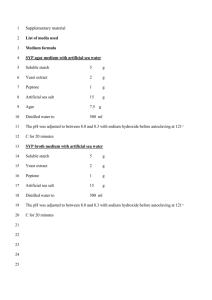A2_Practical_Assessment_Pre
advertisement
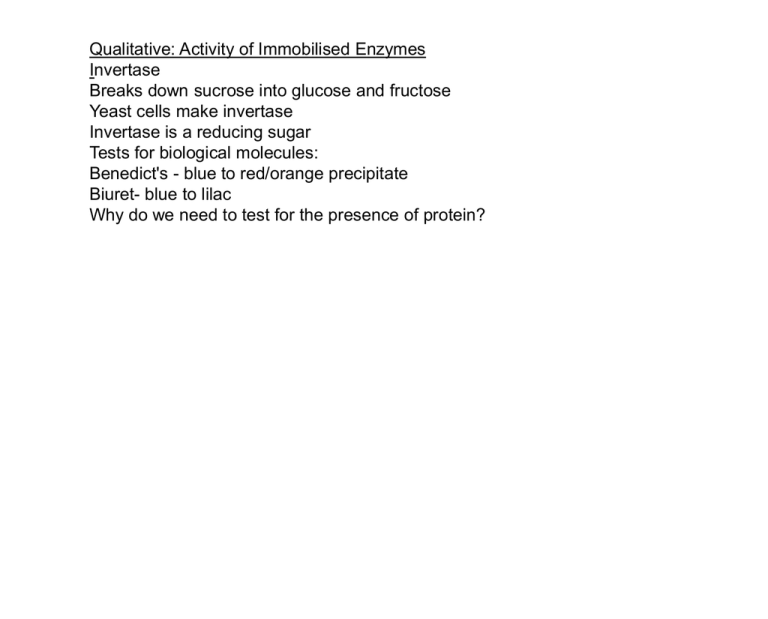
Qualitative: Activity of Immobilised Enzymes Invertase Breaks down sucrose into glucose and fructose Yeast cells make invertase Invertase is a reducing sugar Tests for biological molecules: Benedict's - blue to red/orange precipitate Biuret- blue to lilac Why do we need to test for the presence of protein? Skills: similar size beads columns filled to same level columns left for same length of time before opening the tap Limitations of Benedict's: does not test for other reducing sugars/only indicates the presence of glucose not sensitive enough colour comparison is subjective if the time given is not long enough, it can give incorrect results Advantages of having an immobilised enzyme only: more product no contamination by yeast no sugar is used by the yeast for respiration Advantages of having immobilised yeast: little loss of enzyme enzyme stays inside the yeast cell don't have to extract the enzyme from the yeast using a whole organism is cheaper Quantitative task - Effect of NaCl on Activity of Yeast Cells: 0% - 20% NaCl When would you expect yeast to be most and least active? If results from 5-20% are similar, how might you explain it? If yeast remain active, what does this indicate about their tolerance of NaCl? Which concentration of salt would you expect them to be most and least tolerant of? Evaluative Task: Effect of NaCl on Activity in Yeast (0-20% NaCl) Skills task - identification of how table should be laid out Consider the following table showing the results of an unrelated experiment - the effect of humidity on the rate of transpiration: Distance moved by air bubble 5.2cm Humidity 2.9cm 1% 15mm 5% 2mm 10% 0cm 20% none Identify all the things wrong with the above table Carbon dioxide can be made by yeast cells both aerobically and anaerobically How do you think NaCl affects the rate of respiration? Think Unit 4! Considering the answer to the above, why would you leave the yeast for several minutes before collecting data? to allow time for the NaCl to affect the proteins/respiration/yeast to allow time for the yeast to reach the desired temperature/30 degrees The experiment required students to record the distance moved by yeast suspension up to a maximum of two minutes. Why would recording the volume of gas be an improvement? gas could be collected over a longer time What would you expect the control to be in this experiment? What would you expect to happen to the pH during the experiment? Think back to AS Transport in Animals/respiration Explain why scientists do replicates: increase reliability more easily identify anomalies make comparisons more valid enable us to undertake statistical tests Explain the osmotic effect of NaCl - use AS knowledge!: reduces water potential water diffuses out of yeast cells down the water potential stops the yeast cell working/stops reactions If NaCl affects the proteins involved in respiration, what type of protein might this be? enzyme/sodium:potassium pump/protein channel What level of protein structure would these be and what can you remember about this level of protein from AS knowledge? Tertiary/globular/3D/coiling of alpha-helix/ionic bonds




